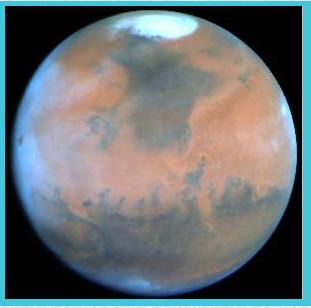 Lesson 7:
Lesson 7:
 Life in the Solar System
Life in the Solar System
|
 7.2
7.2
 Water on Mars?
Water on Mars?

|
 |
Figure 7.2.1 Map of the canals of Mars drawn by Percival Lowell.
Map of the canals of Mars drawn by Percival Lowell.
|
"...in the Martian mind there would be one question perpetually paramount--
the water question. How to procure water enough to support life would be the great
communal problem of the day." Percival Lowell, Mars (1895)
Every cell in our bodies is specifically designed to contain it; we consist
of roughly 72% of the stuff. Each one of us carries some 8 to 12
gallons of it around every day. Water. It is not surprising
that for over a hundred years, we have wondered about its existence
on Mars. Today we know that some form of water does exist on the
planet Mars.
But our image of Mars' water is radically different from that of Percival Lowell, the astronomer
who invented canal-digging Martians living in oases in the Martian desert. In fact,
water can currently exist only as vapor or in solid form on the surface of Mars, owing to
the low atmospheric pressure prevailing there. While almost all of
Earth's water moves around in oceans, rivers and lakes, most of the water on Mars is frozen
deep below the surface, within polar ice caps and in permafrost. The ice caps are
thought to go down to almost 2 miles deep, and cover a land area 1.5 times the size of Texas.
This icy, white vastness is not pure water, but is thought to consist of a
mixture of frozen water and carbon dioxide. The shape and spectrum of the North polar
cap indicates that it contains mostly frozen water.
However, without core samples, we can only estimate how much water there is.

|
 |
Figure 7.2.2 Hubble Space Telescope image
Hubble Space Telescope image
of Mars showing bright Northern Polar Cap.
|
As far as the atmosphere, it holds precious little water vapor. In
comparison with the fluffy white clouds and immense snowdrifts of
Earth, Mars is an acutely dry planet where it never rains. Even the
occasional snowfall on Mars is not water, but atmospheric carbon
dioxide that often melts before it even touches the ground. If all of the
water vapor in Mars' atmosphere precipitated on the planet's
surface, it would form a layer only one hundredth of a millimeter
thick.
Satellite observations lead us to believe that permafrost does exist on the
Martian surface. Several large craters are surrounded by what looks
like mudflows. Frozen water could be present in them underneath the
planet's surface. This suggests the presence of a subterranean
permafrost layer that becomes deeper near the poles due to cooler
temperatures. If we consider all the states in which water resides,
including permafrost, there may be enough water to cover the surface
of Mars with a layer of water 500 meters thick.
A number of different lines of evidence suggests that oceans, rivers
and even glaciers may once have graced the surface of Mars. Canyons
and other landscape features bring to mind the same insistent,
delicate carving that water performs on the Earth's surface.
Strange and well-formed teardrop-shaped mounds might have been
islands in outflow channels hastily carved by severe flooding. Further
evidence was discovered on the Pathfinder mission, when maghemite was
uncovered. Maghemite, a rather common iron oxide, is found throughout
Earth's tropical and subtropical regions. How could this rich,magnetic red ore arise on
Mars' barren surface? The most widely accepted theory describes the origin of
maghemite from the dissolution and oxidization of silicon compounds in watery
environments. Presumably the same is true for Mars.
If Mars had all this water, where is it now? One theory hypothesizes
that Mars lost its atmosphere, which is primarily composed of carbon
dioxide, to space. In order to keep its water, Mars would need the
pressure and warmth generated by a thick blanket of a greenhouse gas
such as carbon dioxide. On earth, the carbon dioxide lost to space is
continually replenished by volcanism. In the fiery days ofMars'
youth, volcanic eruptions and hot springs did the same for Mars.
Eventually, as Mars grew older, it cooled and convection slowed,
cutting back on outgassing. Gradually the store of carbon dioxide was
dissipated and the planet's surface temperature plunged. And
with the loss of atmosphere, ultraviolet rays from the Sun could
penetrate and bombard the water molecules, causing them to
disintegrate into their hydrogen and oxygen components.
Thus evolved Earth's smaller sibling, the dusty red planet of dunes
and craters, a desert more numbing and cold than the frozen expanses
of the Antarctic.
|





















